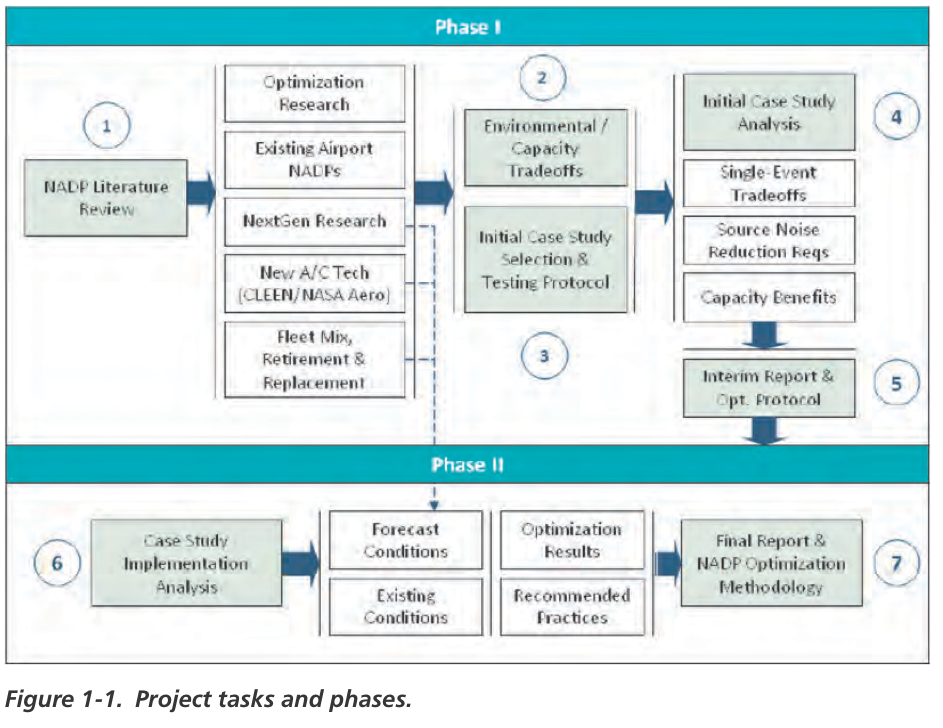AIRPORT COOPERATIVE RESEARCH PROGRAM
Introduction
1.1. Background
The aviation industry has been at the cutting edge of technology since its inception, benefiting various other industries. Transformational changes through the Next Generation Air Transportation System (NextGen) include the introduction of new vehicles, the integration of advanced information technologies into the National Airspace System (NAS), and the implementation of new operational models by air carriers. Such advances call for systemwide approaches to environmental sustainability and innovative solutions to fuel utilization and airport capacity optimization.
Despite notable technological advances, aviation noise is expected to remain the biggest impediment to the expansion of airport capacity in the next 20 years.Virtually all major environmental campaigns against airport and air traffic expansion have centered on community concerns over noise exposure. That said, concerns over climate change and local air quality are gaining momentum and prompting calls for new regulatory schemes to curb emissions of CO2 and other air pollutants—although aviation contributes less than 3% of global greenhouse gas emissions (Kim 2009).
Furthermore, the recent increases in fuel prices have pushed the economic viability of airlines to a breaking point and caused major shifts in demand for air travel. For the foreseeable future, aviation will have to continue contending with volatile oil prices. Despite the potential of alternative and renewable sources of energy, such shifts for air transportation will require changes in terms of aircraft technology that are not immediately available.
There is also a concern that forecast levels of air traffic growth may outpace the introduction of environmentally friendly and fuel-efficient aircraft technology over time. There are design tradeoffs among aircraft-generated noise, emissions, and fuel burn. The introduction of new aircraft technology is only part of the solution. Seeking integrated approaches to the optimization of aircraft operations—along with technological innovation and NAS modernization—can produce a more sustainable growth strategy for aviation while achieving meaningful reductions in both environmental impacts and airline operating costs.
Although Optimized Profile Descent (OPD) procedures have attracted considerable attention for their tradeoff benefits, there has been little discussion of the environmental and operational interdependencies of departure procedures, notably what are known as noise abatement departure profiles (NADPs). Yet, it is in the interest of all stakeholders, particularly members of the community, to evaluate the costs and benefits of operational alternatives, including NADPs, carefully. Stakeholders need such information to decide, for example, whether an incremental improvement in noise exposure justifies an increase in total emissions or vice versa.
Despite current challenges, the aviation industry must continue implementing the NextGen plan and invest in NAS modernization, operational improvements, and new technology. NextGen is an opportunity to resolve long-standing bottlenecks in system capacity and implement more environmentally and energy-efficient operational concepts at airports and in the NAS.
Read full report (PDF) here; Environmental Optimization of Aircraft Departures
About The Airport Cooperative Research Program (ACRP)
www.trb.org/ACRP
”The Airport Cooperative Research Program (ACRP) is an industry-driven, applied research program that develops near-term, practical solutions to problems faced by airport operators. ACRP is managed by the Transportation Research Board (TRB) of the National Academies and sponsored by the Federal Aviation Administration (FAA). The research is conducted by contractors who are selected on the basis of competitive proposals.“
Tags: ACRP, Aircraft Departures, AIRPORT COOPERATIVE RESEARCH PROGRAM, Emissions, Environmental Optimization, Fuel Burn, noise, TRB







 RSS Feed
RSS Feed